Deck 15: Active Filters
سؤال
سؤال
سؤال
سؤال
سؤال
سؤال
سؤال
سؤال
سؤال
سؤال
سؤال
سؤال
سؤال
سؤال
سؤال
سؤال
سؤال
سؤال
سؤال
سؤال
سؤال
سؤال
سؤال
سؤال
سؤال
سؤال
سؤال
سؤال
سؤال
سؤال
سؤال
سؤال
سؤال
سؤال
سؤال

فتح الحزمة
قم بالتسجيل لفتح البطاقات في هذه المجموعة!
Unlock Deck
Unlock Deck
1/35
العب
ملء الشاشة (f)
Deck 15: Active Filters
1
 Figure 4 A test of a filter using an oscilloscope
Figure 4 A test of a filter using an oscilloscopeRefer to Figure 4. The signal on the X channel of the oscilloscope is a(n)
A)sawtooth
B)continuous frequency sinusoidal wave
C)amplitude modulated frequency
D)constant amplitude swept frequency
A
2
The critical frequency of a high- pass filter is where the response is
A)-20 dB from the passband response
B)at its highest point
C)-3 dB from the passband response
D)-6 dB from the passband response
A)-20 dB from the passband response
B)at its highest point
C)-3 dB from the passband response
D)-6 dB from the passband response
C
3
A high Q bandpass filter
A)can reject a specific frequency
B)has a narrow bandwidth
C)is usually constructed from cascaded low- pass and high- pass filters
D)all of the above
A)can reject a specific frequency
B)has a narrow bandwidth
C)is usually constructed from cascaded low- pass and high- pass filters
D)all of the above
B
4
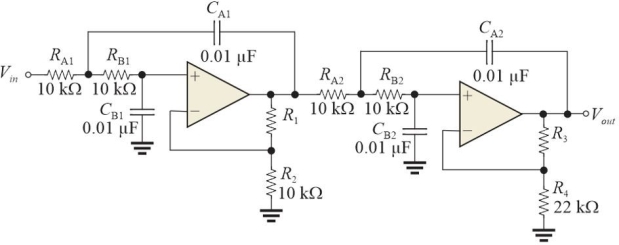 Figure 1 Stage 1: DF = 1.848 and R1/R2 = 0.152; stage 2: DF = 0.765 and R3/R4 =1.235.
Figure 1 Stage 1: DF = 1.848 and R1/R2 = 0.152; stage 2: DF = 0.765 and R3/R4 =1.235.Refer to Figure 1 with values as given. R3 should have a value of
A)1.8 k▲
B)1.5 k▲
C)1.2 k▲
D)none of the above

فتح الحزمة
افتح القفل للوصول البطاقات البالغ عددها 35 في هذه المجموعة.
فتح الحزمة
k this deck
5
The biquad filter has
A)a summing amplifier, an inverting amplifier, and an integrator
B)an inverting amplifier and two differentiators
C)a summing amplifier and two differentiators
D)an inverting amplifier and two integrators
A)a summing amplifier, an inverting amplifier, and an integrator
B)an inverting amplifier and two differentiators
C)a summing amplifier and two differentiators
D)an inverting amplifier and two integrators

فتح الحزمة
افتح القفل للوصول البطاقات البالغ عددها 35 في هذه المجموعة.
فتح الحزمة
k this deck
6
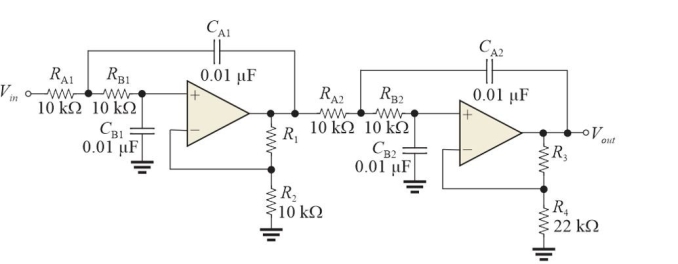 Figure 1 Stage 1: DF = 1.848 and R1/R2 = 0.152; stage 2: DF = 0.765 and R3/R4 =1.235.
Figure 1 Stage 1: DF = 1.848 and R1/R2 = 0.152; stage 2: DF = 0.765 and R3/R4 =1.235.Refer to Figure 1 with values as given. R1 should have a value of
A)1.2 k▲
B)1.8 k▲
C)1.5 k▲
D)none of the above

فتح الحزمة
افتح القفل للوصول البطاقات البالغ عددها 35 في هذه المجموعة.
فتح الحزمة
k this deck
7
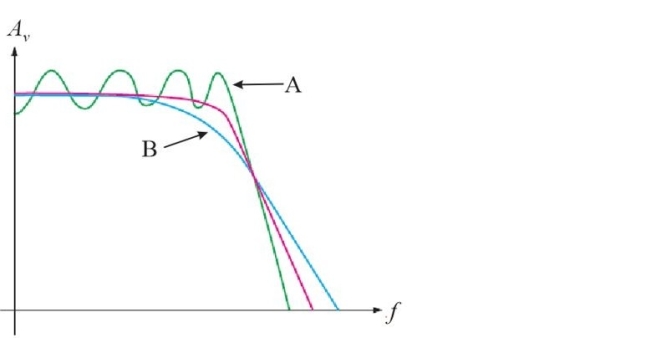 Figure 5 Response curve for three different filters
Figure 5 Response curve for three different filtersRefer to Figure 5. The response labeled "A" represents a
A)Butterworth response
B)Bessel response
C)Chebyshev response
D)none of the above

فتح الحزمة
افتح القفل للوصول البطاقات البالغ عددها 35 في هذه المجموعة.
فتح الحزمة
k this deck
8
A low- pass filter has a critical frequency of 10 kHz. The bandpass is
A)20 kHz
B)5.0 kHz
C)15 kHz
D)10 kHz
A)20 kHz
B)5.0 kHz
C)15 kHz
D)10 kHz

فتح الحزمة
افتح القفل للوصول البطاقات البالغ عددها 35 في هذه المجموعة.
فتح الحزمة
k this deck
9
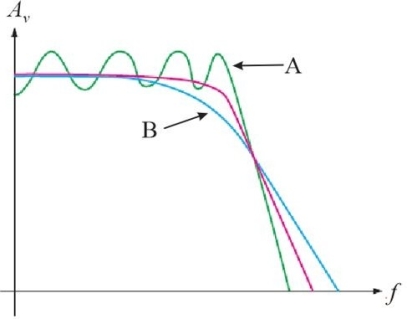 Figure 5 Response curve for three different filters
Figure 5 Response curve for three different filtersRefer to Figure 5. The response labeled "B" represents a
A)Butterworth response
B)Bessel response
C)Chebyshev response
D)none of the above

فتح الحزمة
افتح القفل للوصول البطاقات البالغ عددها 35 في هذه المجموعة.
فتح الحزمة
k this deck
10
 Figure 2 Note that the capacitors have different values.
Figure 2 Note that the capacitors have different values.Refer to Figure 2. The fc for the first section is
A)800 Hz
B)160 Hz
C)80 Hz
D)1.6 kHz

فتح الحزمة
افتح القفل للوصول البطاقات البالغ عددها 35 في هذه المجموعة.
فتح الحزمة
k this deck
11
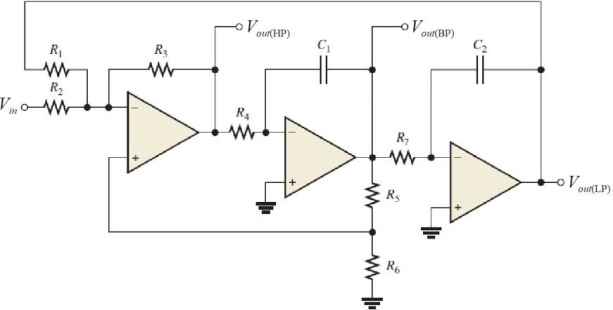 Figure 3
Figure 3Refer to Figure 3. This type of filter is called a
A)biquad filter
B)Sallen- Key filter
C)multiple- feedback filter
D)state- variable filter

فتح الحزمة
افتح القفل للوصول البطاقات البالغ عددها 35 في هذه المجموعة.
فتح الحزمة
k this deck
12
The bandwidth of a bandpass filter is measured at
A)the -2 dB frequencies
B)the -6 dB frequencies
C)the -4 dB frequencies
D)none of the above
A)the -2 dB frequencies
B)the -6 dB frequencies
C)the -4 dB frequencies
D)none of the above

فتح الحزمة
افتح القفل للوصول البطاقات البالغ عددها 35 في هذه المجموعة.
فتح الحزمة
k this deck
13
The best response to use for pulses is
A)Butterworth response
B)Bessel response
C)Chebyshev response
D)none of the above
A)Butterworth response
B)Bessel response
C)Chebyshev response
D)none of the above

فتح الحزمة
افتح القفل للوصول البطاقات البالغ عددها 35 في هذه المجموعة.
فتح الحزمة
k this deck
14
A basic one- pole RC low- pass filter has fc = 5.9 kHz using a 0.01 µF capacitor. The resistor value is
A)2.7 k▲
B)1.6 k▲
C)16 k▲
D)270 ▲
A)2.7 k▲
B)1.6 k▲
C)16 k▲
D)270 ▲

فتح الحزمة
افتح القفل للوصول البطاقات البالغ عددها 35 في هذه المجموعة.
فتح الحزمة
k this deck
15
 Figure 1 Stage 1: DF = 1.848 and R1/R2 = 0.152; stage 2: DF = 0.765 and R3/R4 =1.235.
Figure 1 Stage 1: DF = 1.848 and R1/R2 = 0.152; stage 2: DF = 0.765 and R3/R4 =1.235.Refer to Figure 1. Assume Vin = 1.0 Vpp sine wave at 20 kHz. At this frequency, Vout is approximately
A)1.0 Vpp
B)10 mVpp
C)1.0 mVpp
D)100 µVpp

فتح الحزمة
افتح القفل للوصول البطاقات البالغ عددها 35 في هذه المجموعة.
فتح الحزمة
k this deck
16
 Figure 2 Note that the capacitors have different values.
Figure 2 Note that the capacitors have different values.Refer to Figure 2. Assume the capacitors in section 1 are made larger. This change will
A)decrease the bandwidth
B)increase the bandwidth
C)not affect the bandwidth

فتح الحزمة
افتح القفل للوصول البطاقات البالغ عددها 35 في هذه المجموعة.
فتح الحزمة
k this deck
17
 Figure 4 A test of a filter using an oscilloscope
Figure 4 A test of a filter using an oscilloscopeRefer to Figure 4. The block with the ? on it represents a
A)low- pass filter
B)impedance matching circuit
C)detector
D)amplifier

فتح الحزمة
افتح القفل للوصول البطاقات البالغ عددها 35 في هذه المجموعة.
فتح الحزمة
k this deck
18
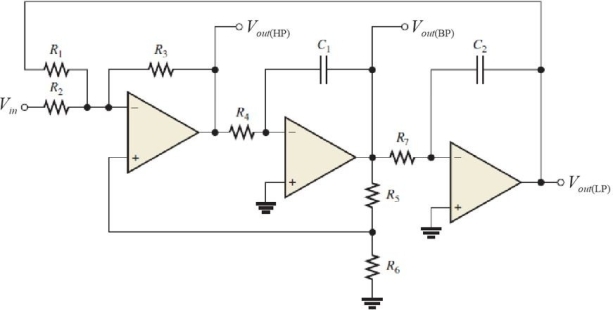 Figure 3
Figure 3Refer to Figure 3. An advantage of this type of filter is that it
A)the low and high- pass outputs are equivalent to a 4- pole filter
B)can be optimized for all three outputs
C)the bandpass output can have a very high Q
D)all of the above

فتح الحزمة
افتح القفل للوصول البطاقات البالغ عددها 35 في هذه المجموعة.
فتح الحزمة
k this deck
19
Assume a high- pass filter and a low- pass filter are cascaded to form a band- pass filter. The upper cutoff frequency will be determined by
A)the high- pass filter
B)answer depends on the order of the filters
C)the low- pass filter
D)none of the above
A)the high- pass filter
B)answer depends on the order of the filters
C)the low- pass filter
D)none of the above

فتح الحزمة
افتح القفل للوصول البطاقات البالغ عددها 35 في هذه المجموعة.
فتح الحزمة
k this deck
20
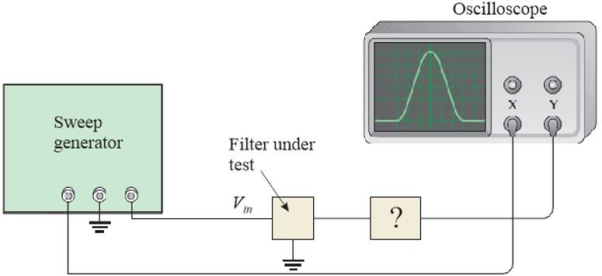 Figure 4 A test of a filter using an oscilloscope
Figure 4 A test of a filter using an oscilloscopeRefer to Figure 4. The input signal to the filter (Vin)is a(n)
A)continuous frequency sinusoidal wave
B)amplitude modulated frequency
C)constant amplitude swept frequency
D)sawtooth

فتح الحزمة
افتح القفل للوصول البطاقات البالغ عددها 35 في هذه المجموعة.
فتح الحزمة
k this deck
21
 Figure 1 Stage 1: DF = 1.848 and R1/R2 = 0.152; stage 2: DF = 0.765 and R3/R4 =1.235.
Figure 1 Stage 1: DF = 1.848 and R1/R2 = 0.152; stage 2: DF = 0.765 and R3/R4 =1.235.Refer to Figure 1. The type of filter is a
A)low- pass Sallen- Key filter
B)high- pass Sallen- Key filter
C)low- pass biquad filter
D)high- pass biquad filter

فتح الحزمة
افتح القفل للوصول البطاقات البالغ عددها 35 في هذه المجموعة.
فتح الحزمة
k this deck
22
 Figure 1 Stage 1: DF = 1.848 and R1/R2 = 0.152; stage 2: DF = 0.765 and R3/R4 =1.235.
Figure 1 Stage 1: DF = 1.848 and R1/R2 = 0.152; stage 2: DF = 0.765 and R3/R4 =1.235.Refer to Figure 1. The ideal roll- off rate is
A)-120 dB/decade
B)-80 dB/decade
C)-40 dB/decade
D)-20 dB/decade

فتح الحزمة
افتح القفل للوصول البطاقات البالغ عددها 35 في هذه المجموعة.
فتح الحزمة
k this deck
23
The damping factor, DF, is determined by the number of poles in a filter.

فتح الحزمة
افتح القفل للوصول البطاقات البالغ عددها 35 في هذه المجموعة.
فتح الحزمة
k this deck
24
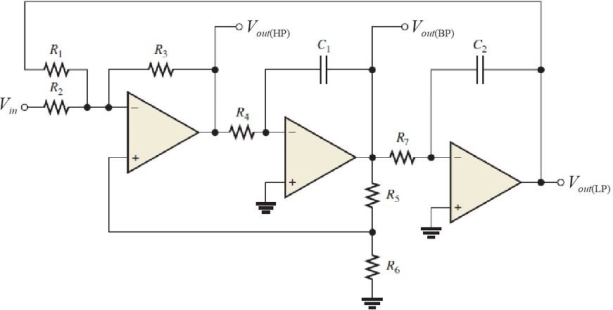 Figure 3
Figure 3Refer to Figure 3. The last stage is
A)a differentiator
B)an inverting amp
C)an integrator
D)a summing amplifier

فتح الحزمة
افتح القفل للوصول البطاقات البالغ عددها 35 في هذه المجموعة.
فتح الحزمة
k this deck
25
A basic RC (one R, oneC)filter has a -20dB/decade roll- off.

فتح الحزمة
افتح القفل للوصول البطاقات البالغ عددها 35 في هذه المجموعة.
فتح الحزمة
k this deck
26
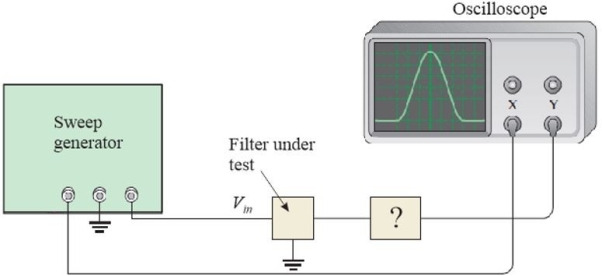 Figure 4 A test of a filter using an oscilloscope
Figure 4 A test of a filter using an oscilloscopeRefer to Figure 4. The oscilloscope needs to
A)generate an internal time base
B)use normal triggering
C)use external triggering
D)be in X- Y mode

فتح الحزمة
افتح القفل للوصول البطاقات البالغ عددها 35 في هذه المجموعة.
فتح الحزمة
k this deck
27
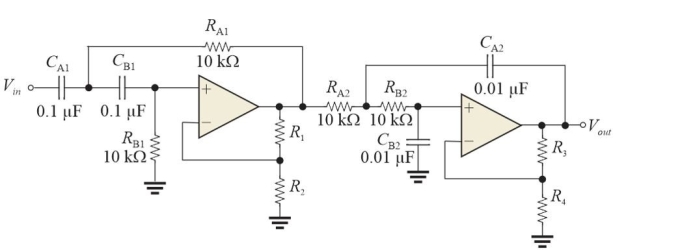 Figure 2 Note that the capacitors have different values.
Figure 2 Note that the capacitors have different values.Refer to Figure 2. The circuit is a
A)high- pass filter
B)low- pass filter
C)notch filter
D)bandpass filter

فتح الحزمة
افتح القفل للوصول البطاقات البالغ عددها 35 في هذه المجموعة.
فتح الحزمة
k this deck
28
A single- pole filter cannot be used as a notch filter.

فتح الحزمة
افتح القفل للوصول البطاقات البالغ عددها 35 في هذه المجموعة.
فتح الحزمة
k this deck
29
The Q of a band- pass filter is inversely proportional to the damping factor.

فتح الحزمة
افتح القفل للوصول البطاقات البالغ عددها 35 في هذه المجموعة.
فتح الحزمة
k this deck
30
 Figure 2 Note that the capacitors have different values.
Figure 2 Note that the capacitors have different values.Refer to Figure 2. Assume section 1 and section 2 are exchanged. This will
A)change the overall response
B)change the type of filter
C)both A and B
D)neither A nor B

فتح الحزمة
افتح القفل للوصول البطاقات البالغ عددها 35 في هذه المجموعة.
فتح الحزمة
k this deck
31
The Chebyshev filter is noted for its flat response in the passband.

فتح الحزمة
افتح القفل للوصول البطاقات البالغ عددها 35 في هذه المجموعة.
فتح الحزمة
k this deck
32
 Figure 2 Note that the capacitors have different values.
Figure 2 Note that the capacitors have different values.Refer to Figure 2. The fc for the second section is
A)1.6 kHz
B)800 Hz
C)80 Hz
D)160 Hz

فتح الحزمة
افتح القفل للوصول البطاقات البالغ عددها 35 في هذه المجموعة.
فتح الحزمة
k this deck
33
A biquad filter has both low- pass and high- pass outputs.

فتح الحزمة
افتح القفل للوصول البطاقات البالغ عددها 35 في هذه المجموعة.
فتح الحزمة
k this deck
34
The damping factor, DF, affects an active filter's response characteristics.

فتح الحزمة
افتح القفل للوصول البطاقات البالغ عددها 35 في هذه المجموعة.
فتح الحزمة
k this deck
35
The bandwidth of a basic band- pass filter is measured between the center frequency and a critical frequency.

فتح الحزمة
افتح القفل للوصول البطاقات البالغ عددها 35 في هذه المجموعة.
فتح الحزمة
k this deck








